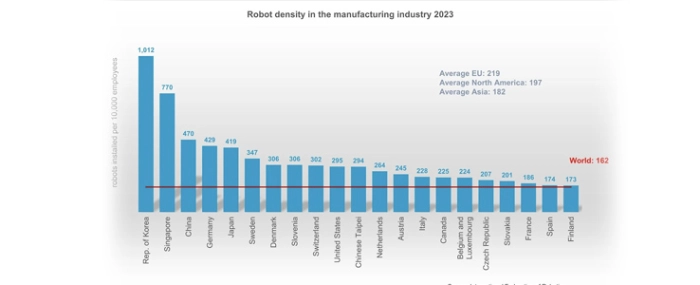
Global robot density in factories have doubled in seven years
Robot adoption in factories continues at high speed: The new global average robot density reached a record of 162 units per 10,000 employees in 2023 – more than double the number measured only seven years ago (74 units), reports the International Federation of Robotics (IFR).
“Robot density serves as a barometer to track the degree of automation adoption in the manufacturing industry around the world," says Takayuki Ito, President of the International Federation of Robotics, in a press release. “This year's runner-up is China, which ranks third worldwide behind Korea and Singapore, but right up with Germany and Japan."
The European Union has a robot density of 219 units per 10,000 employees, an increase of 5.2%, with Germany, Sweden, Denmark and Slovenia in the global top ten.
North America's robot density is 197 units per 10,000 employees, which represents and increase of 4,2%. The United States ranks tenth in the world among the most automated countries in the manufacturing industry.
Asia has a robot density of 182 units per 10,000 persons employed in manufacturing – an increase of 7.6%. The Republic of Korea, Singapore, mainland China and Japan are among the top ten most automated countries.
Top countries
South Korea leads the world in industrial robot use, with 1,012 robots per 10,000 employees. Robot density has on average grown by 5% annually since 2018, driven by its prominent electronics and automotive industries — the largest buyers of industrial robots.
Singapore ranks second with 770 robots per 10,000 employees. Its small workforce in manufacturing allows for high robot density in the manufacturing industry.
China rose to third place in 2023, surpassing Germany and Japan, with a robot density of 470 per 10,000 employees (up from 402 in 2022). Since entering the top 10 in 2019, China has doubled its robot density in just four years, driven by its focus on automation.
Germany ranks fourth with 429 robots per 10,000 employees, with a 5% annual growth in robot density since 2018. Japan is fifth with 419 robots. Robot density of the world's predominant robot manufacturing country grew by 7% on average each year between 2018-2023.
The United States ranks tenth globally in robot density, with 295 robots in 2023.

